Financial Performance Analysis Report - Semester 1, University X
VerifiedAdded on 2022/12/30
|14
|3833
|75
Report
AI Summary
This report provides an in-depth analysis of financial performance, focusing on management accounting techniques used for decision-making within organizations. It explores the significance of environmental cost management, detailing how companies manage environmental impacts and costs associated with their operations, including pollution, waste disposal, and environmental planning. The report highlights the importance of decision-making in various aspects of financial management, such as budgeting and investment analysis. It then delves into planning tools like financial planning, cost analysis, cash flow analysis, budgetary control, marginal costing, and statistical techniques. Furthermore, it discusses the relevancy of budgetary control and KPIs in enhancing financial performance. Finally, it outlines strategies for achieving financial sustainability, emphasizing environmental accounting, the importance of green accounting, and the role of environmental cost in the financial operations of a company.
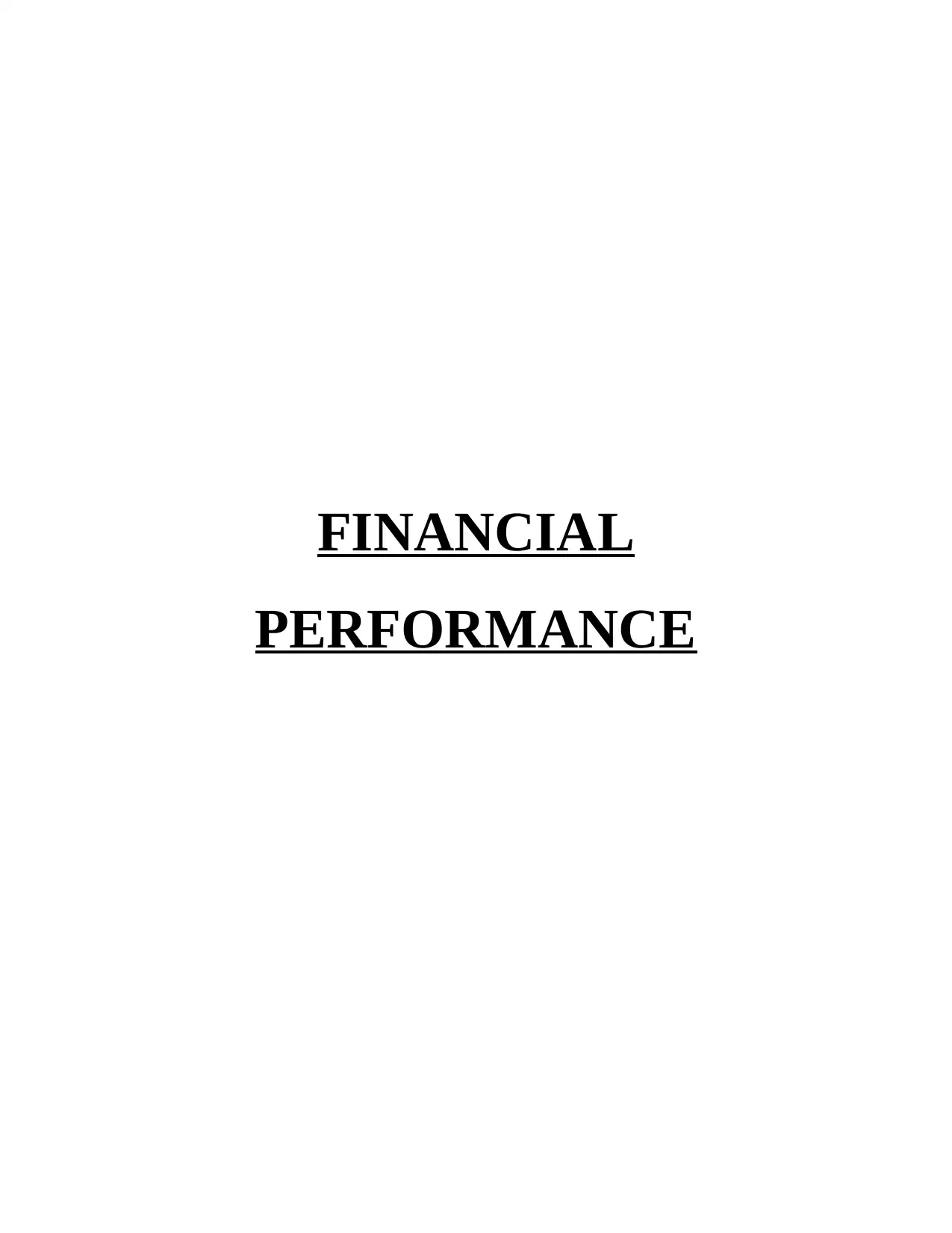
FINANCIAL
PERFORMANCE
PERFORMANCE
Paraphrase This Document
Need a fresh take? Get an instant paraphrase of this document with our AI Paraphraser
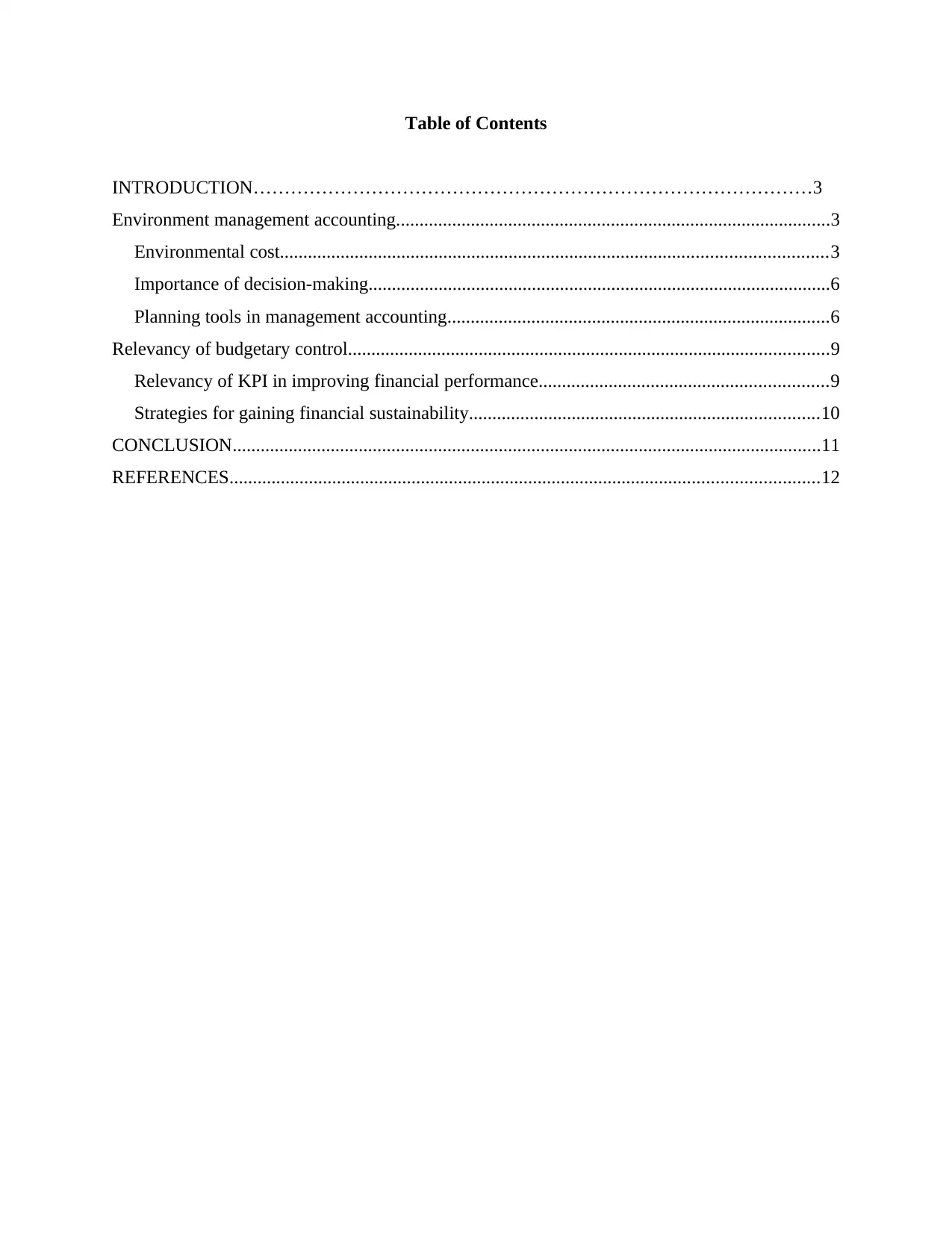
Table of Contents
INTRODUCTION………………………………………………………………………………3
Environment management accounting.............................................................................................3
Environmental cost.....................................................................................................................3
Importance of decision-making...................................................................................................6
Planning tools in management accounting..................................................................................6
Relevancy of budgetary control.......................................................................................................9
Relevancy of KPI in improving financial performance..............................................................9
Strategies for gaining financial sustainability...........................................................................10
CONCLUSION..............................................................................................................................11
REFERENCES..............................................................................................................................12
INTRODUCTION………………………………………………………………………………3
Environment management accounting.............................................................................................3
Environmental cost.....................................................................................................................3
Importance of decision-making...................................................................................................6
Planning tools in management accounting..................................................................................6
Relevancy of budgetary control.......................................................................................................9
Relevancy of KPI in improving financial performance..............................................................9
Strategies for gaining financial sustainability...........................................................................10
CONCLUSION..............................................................................................................................11
REFERENCES..............................................................................................................................12
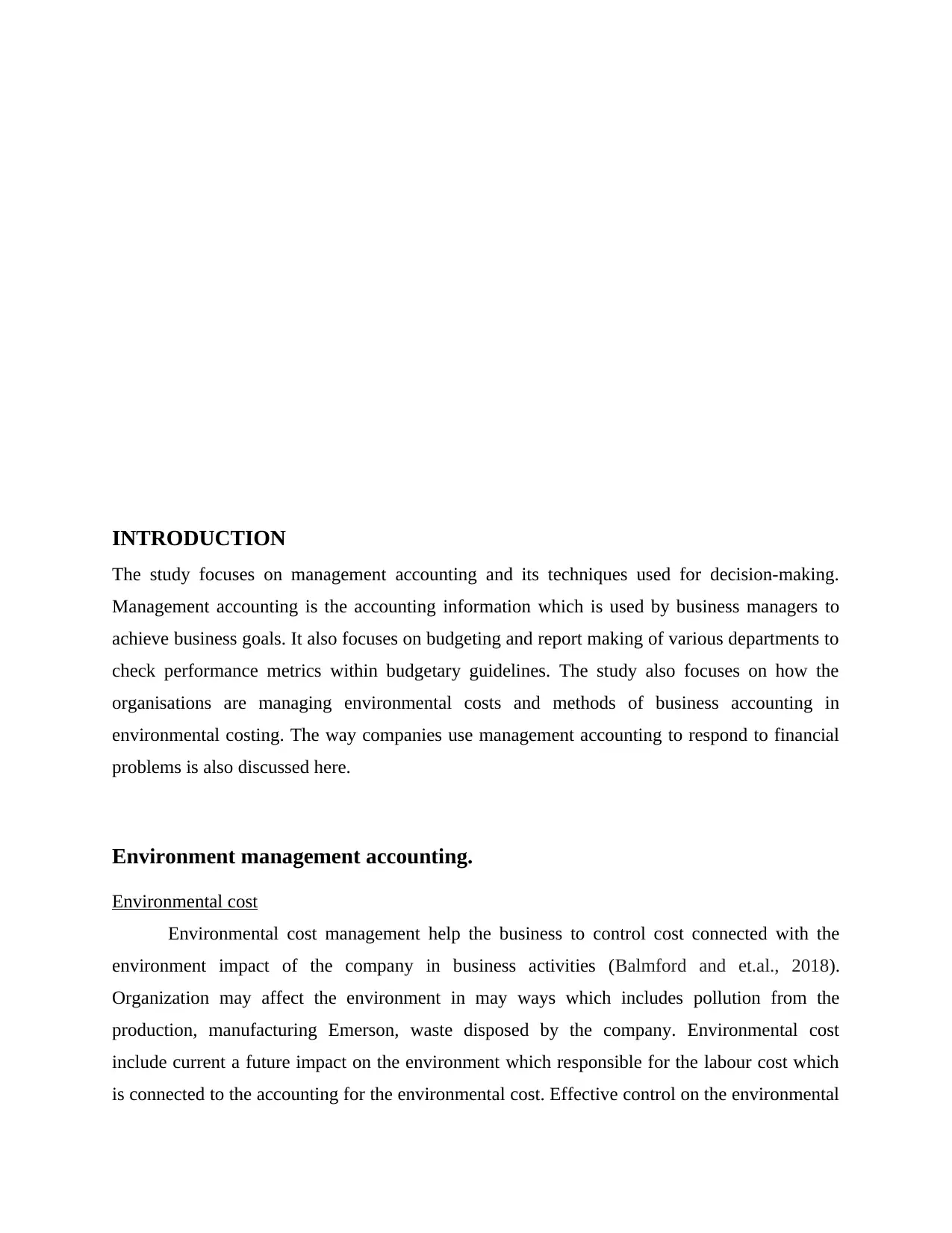
INTRODUCTION
The study focuses on management accounting and its techniques used for decision-making.
Management accounting is the accounting information which is used by business managers to
achieve business goals. It also focuses on budgeting and report making of various departments to
check performance metrics within budgetary guidelines. The study also focuses on how the
organisations are managing environmental costs and methods of business accounting in
environmental costing. The way companies use management accounting to respond to financial
problems is also discussed here.
Environment management accounting.
Environmental cost
Environmental cost management help the business to control cost connected with the
environment impact of the company in business activities (Balmford and et.al., 2018).
Organization may affect the environment in may ways which includes pollution from the
production, manufacturing Emerson, waste disposed by the company. Environmental cost
include current a future impact on the environment which responsible for the labour cost which
is connected to the accounting for the environmental cost. Effective control on the environmental
The study focuses on management accounting and its techniques used for decision-making.
Management accounting is the accounting information which is used by business managers to
achieve business goals. It also focuses on budgeting and report making of various departments to
check performance metrics within budgetary guidelines. The study also focuses on how the
organisations are managing environmental costs and methods of business accounting in
environmental costing. The way companies use management accounting to respond to financial
problems is also discussed here.
Environment management accounting.
Environmental cost
Environmental cost management help the business to control cost connected with the
environment impact of the company in business activities (Balmford and et.al., 2018).
Organization may affect the environment in may ways which includes pollution from the
production, manufacturing Emerson, waste disposed by the company. Environmental cost
include current a future impact on the environment which responsible for the labour cost which
is connected to the accounting for the environmental cost. Effective control on the environmental
⊘ This is a preview!⊘
Do you want full access?
Subscribe today to unlock all pages.

Trusted by 1+ million students worldwide
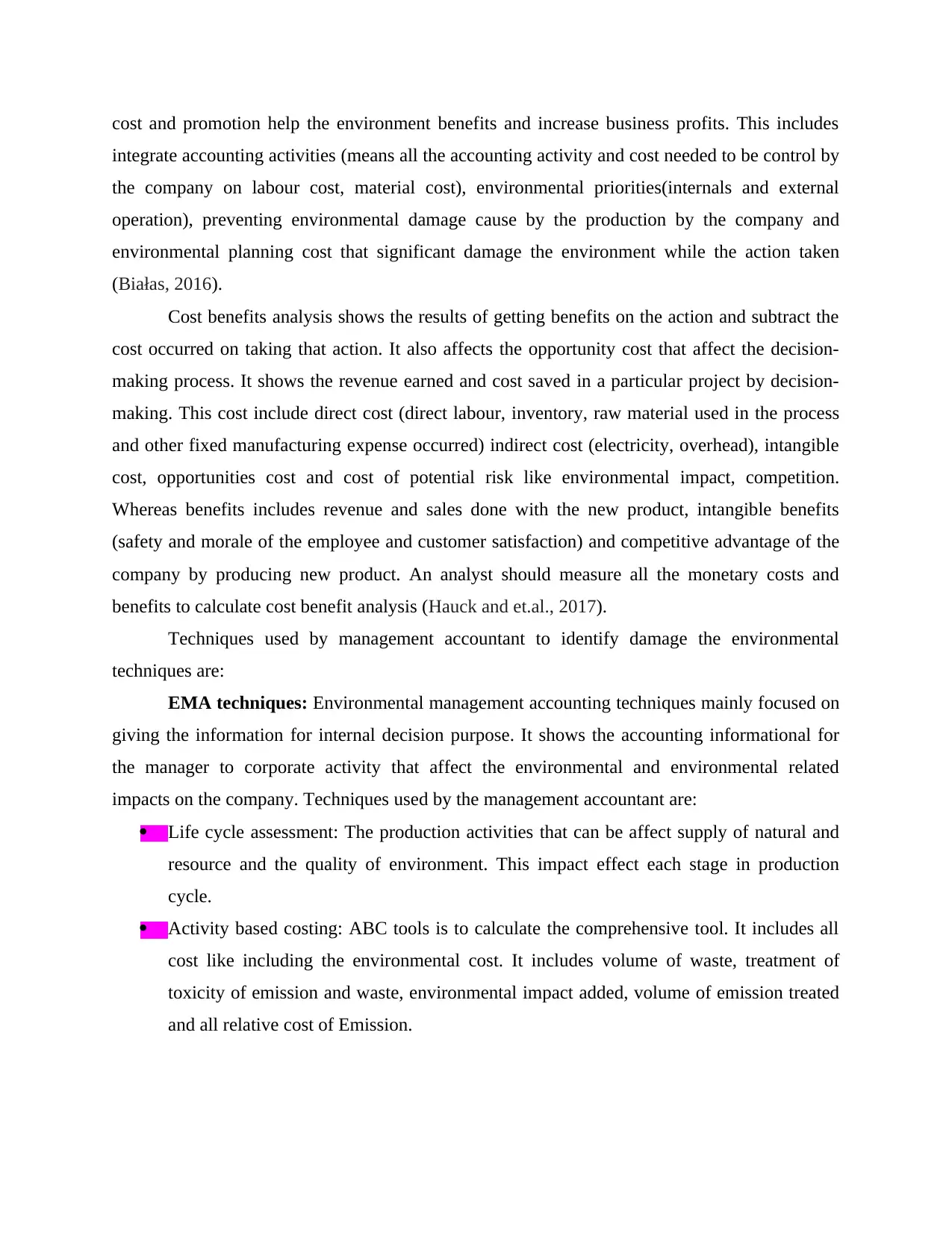
cost and promotion help the environment benefits and increase business profits. This includes
integrate accounting activities (means all the accounting activity and cost needed to be control by
the company on labour cost, material cost), environmental priorities(internals and external
operation), preventing environmental damage cause by the production by the company and
environmental planning cost that significant damage the environment while the action taken
(Białas, 2016).
Cost benefits analysis shows the results of getting benefits on the action and subtract the
cost occurred on taking that action. It also affects the opportunity cost that affect the decision-
making process. It shows the revenue earned and cost saved in a particular project by decision-
making. This cost include direct cost (direct labour, inventory, raw material used in the process
and other fixed manufacturing expense occurred) indirect cost (electricity, overhead), intangible
cost, opportunities cost and cost of potential risk like environmental impact, competition.
Whereas benefits includes revenue and sales done with the new product, intangible benefits
(safety and morale of the employee and customer satisfaction) and competitive advantage of the
company by producing new product. An analyst should measure all the monetary costs and
benefits to calculate cost benefit analysis (Hauck and et.al., 2017).
Techniques used by management accountant to identify damage the environmental
techniques are:
EMA techniques: Environmental management accounting techniques mainly focused on
giving the information for internal decision purpose. It shows the accounting informational for
the manager to corporate activity that affect the environmental and environmental related
impacts on the company. Techniques used by the management accountant are:
Life cycle assessment: The production activities that can be affect supply of natural and
resource and the quality of environment. This impact effect each stage in production
cycle.
Activity based costing: ABC tools is to calculate the comprehensive tool. It includes all
cost like including the environmental cost. It includes volume of waste, treatment of
toxicity of emission and waste, environmental impact added, volume of emission treated
and all relative cost of Emission.
integrate accounting activities (means all the accounting activity and cost needed to be control by
the company on labour cost, material cost), environmental priorities(internals and external
operation), preventing environmental damage cause by the production by the company and
environmental planning cost that significant damage the environment while the action taken
(Białas, 2016).
Cost benefits analysis shows the results of getting benefits on the action and subtract the
cost occurred on taking that action. It also affects the opportunity cost that affect the decision-
making process. It shows the revenue earned and cost saved in a particular project by decision-
making. This cost include direct cost (direct labour, inventory, raw material used in the process
and other fixed manufacturing expense occurred) indirect cost (electricity, overhead), intangible
cost, opportunities cost and cost of potential risk like environmental impact, competition.
Whereas benefits includes revenue and sales done with the new product, intangible benefits
(safety and morale of the employee and customer satisfaction) and competitive advantage of the
company by producing new product. An analyst should measure all the monetary costs and
benefits to calculate cost benefit analysis (Hauck and et.al., 2017).
Techniques used by management accountant to identify damage the environmental
techniques are:
EMA techniques: Environmental management accounting techniques mainly focused on
giving the information for internal decision purpose. It shows the accounting informational for
the manager to corporate activity that affect the environmental and environmental related
impacts on the company. Techniques used by the management accountant are:
Life cycle assessment: The production activities that can be affect supply of natural and
resource and the quality of environment. This impact effect each stage in production
cycle.
Activity based costing: ABC tools is to calculate the comprehensive tool. It includes all
cost like including the environmental cost. It includes volume of waste, treatment of
toxicity of emission and waste, environmental impact added, volume of emission treated
and all relative cost of Emission.
Paraphrase This Document
Need a fresh take? Get an instant paraphrase of this document with our AI Paraphraser
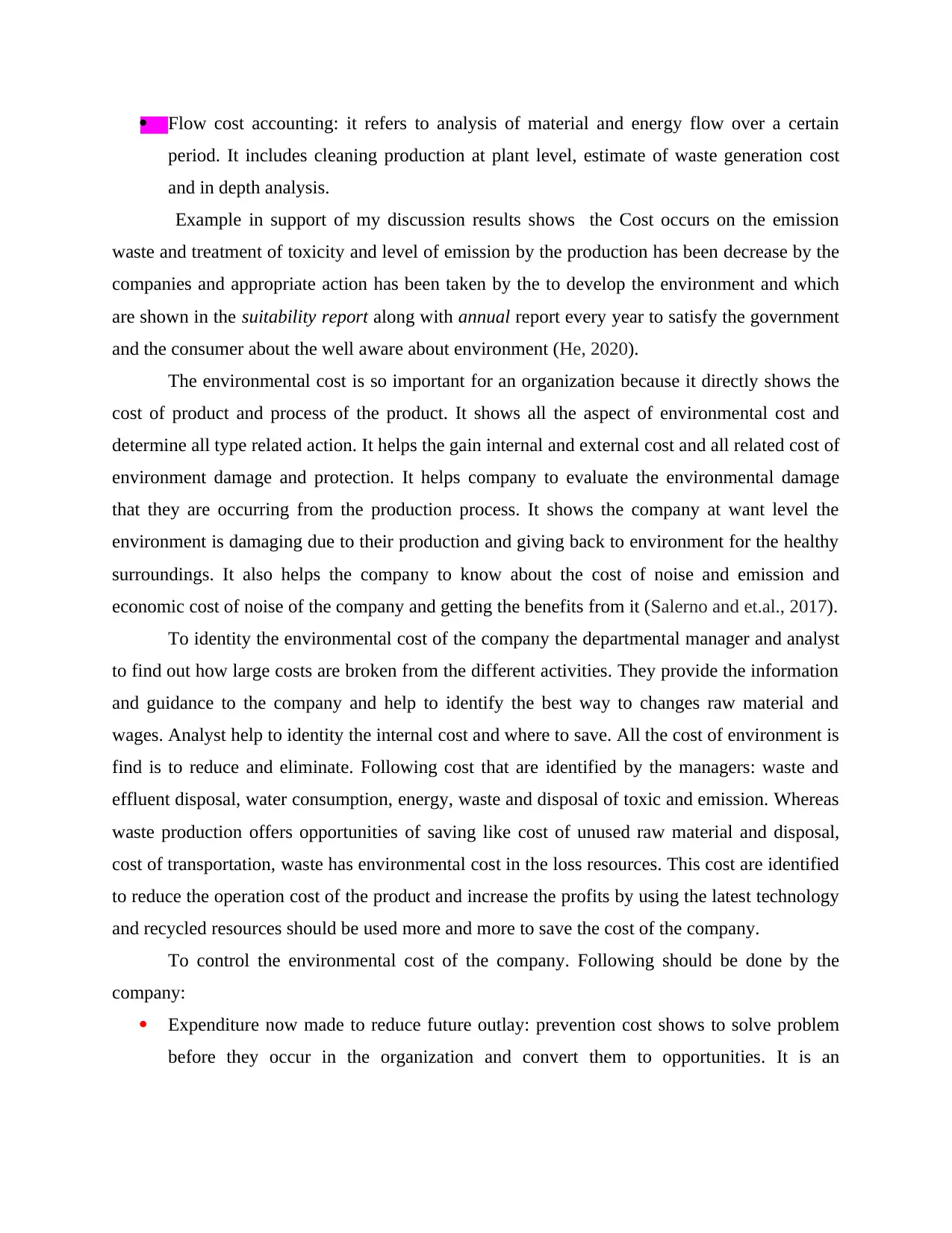
Flow cost accounting: it refers to analysis of material and energy flow over a certain
period. It includes cleaning production at plant level, estimate of waste generation cost
and in depth analysis.
Example in support of my discussion results shows the Cost occurs on the emission
waste and treatment of toxicity and level of emission by the production has been decrease by the
companies and appropriate action has been taken by the to develop the environment and which
are shown in the suitability report along with annual report every year to satisfy the government
and the consumer about the well aware about environment (He, 2020).
The environmental cost is so important for an organization because it directly shows the
cost of product and process of the product. It shows all the aspect of environmental cost and
determine all type related action. It helps the gain internal and external cost and all related cost of
environment damage and protection. It helps company to evaluate the environmental damage
that they are occurring from the production process. It shows the company at want level the
environment is damaging due to their production and giving back to environment for the healthy
surroundings. It also helps the company to know about the cost of noise and emission and
economic cost of noise of the company and getting the benefits from it (Salerno and et.al., 2017).
To identity the environmental cost of the company the departmental manager and analyst
to find out how large costs are broken from the different activities. They provide the information
and guidance to the company and help to identify the best way to changes raw material and
wages. Analyst help to identity the internal cost and where to save. All the cost of environment is
find is to reduce and eliminate. Following cost that are identified by the managers: waste and
effluent disposal, water consumption, energy, waste and disposal of toxic and emission. Whereas
waste production offers opportunities of saving like cost of unused raw material and disposal,
cost of transportation, waste has environmental cost in the loss resources. This cost are identified
to reduce the operation cost of the product and increase the profits by using the latest technology
and recycled resources should be used more and more to save the cost of the company.
To control the environmental cost of the company. Following should be done by the
company:
Expenditure now made to reduce future outlay: prevention cost shows to solve problem
before they occur in the organization and convert them to opportunities. It is an
period. It includes cleaning production at plant level, estimate of waste generation cost
and in depth analysis.
Example in support of my discussion results shows the Cost occurs on the emission
waste and treatment of toxicity and level of emission by the production has been decrease by the
companies and appropriate action has been taken by the to develop the environment and which
are shown in the suitability report along with annual report every year to satisfy the government
and the consumer about the well aware about environment (He, 2020).
The environmental cost is so important for an organization because it directly shows the
cost of product and process of the product. It shows all the aspect of environmental cost and
determine all type related action. It helps the gain internal and external cost and all related cost of
environment damage and protection. It helps company to evaluate the environmental damage
that they are occurring from the production process. It shows the company at want level the
environment is damaging due to their production and giving back to environment for the healthy
surroundings. It also helps the company to know about the cost of noise and emission and
economic cost of noise of the company and getting the benefits from it (Salerno and et.al., 2017).
To identity the environmental cost of the company the departmental manager and analyst
to find out how large costs are broken from the different activities. They provide the information
and guidance to the company and help to identify the best way to changes raw material and
wages. Analyst help to identity the internal cost and where to save. All the cost of environment is
find is to reduce and eliminate. Following cost that are identified by the managers: waste and
effluent disposal, water consumption, energy, waste and disposal of toxic and emission. Whereas
waste production offers opportunities of saving like cost of unused raw material and disposal,
cost of transportation, waste has environmental cost in the loss resources. This cost are identified
to reduce the operation cost of the product and increase the profits by using the latest technology
and recycled resources should be used more and more to save the cost of the company.
To control the environmental cost of the company. Following should be done by the
company:
Expenditure now made to reduce future outlay: prevention cost shows to solve problem
before they occur in the organization and convert them to opportunities. It is an
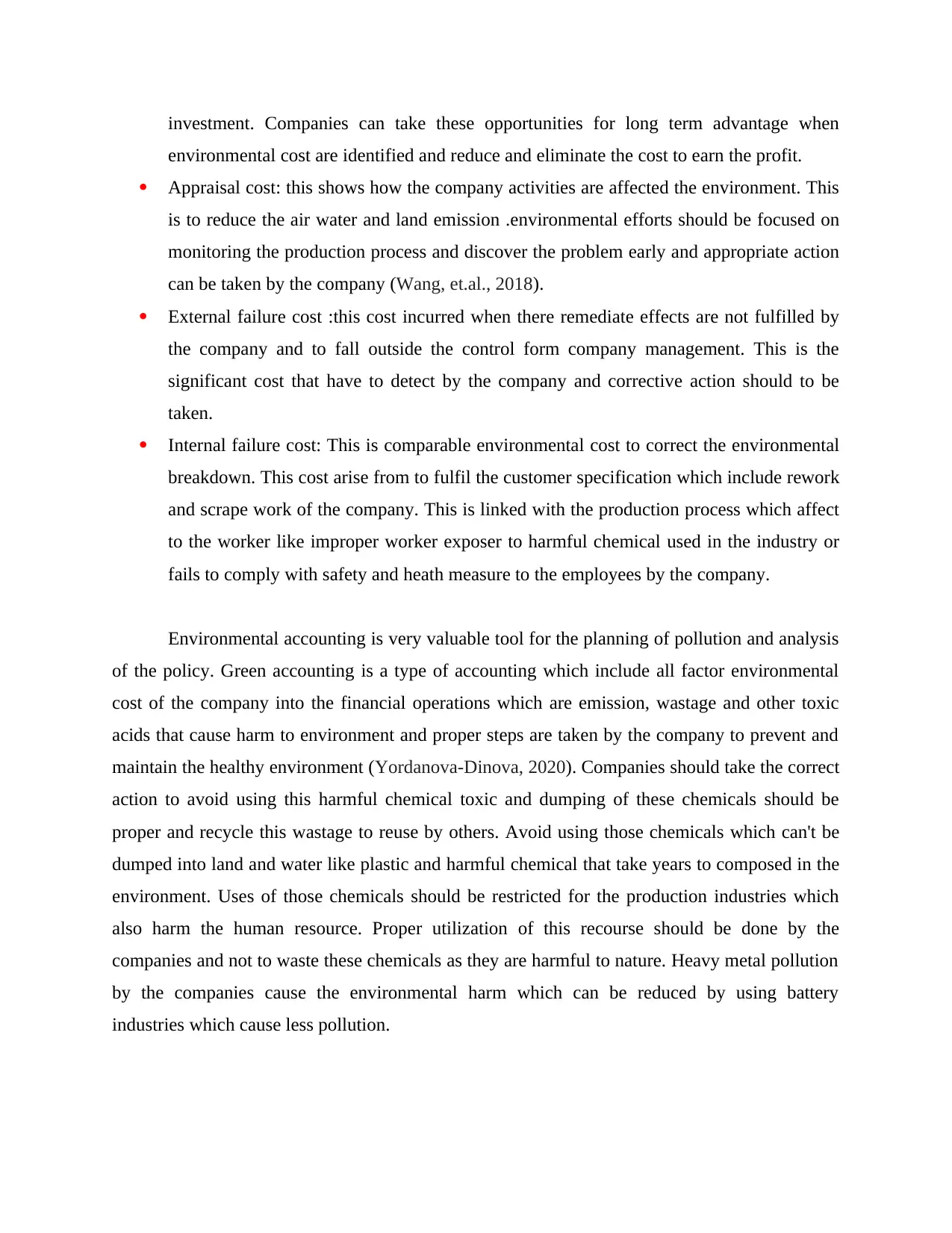
investment. Companies can take these opportunities for long term advantage when
environmental cost are identified and reduce and eliminate the cost to earn the profit.
Appraisal cost: this shows how the company activities are affected the environment. This
is to reduce the air water and land emission .environmental efforts should be focused on
monitoring the production process and discover the problem early and appropriate action
can be taken by the company (Wang, et.al., 2018).
External failure cost :this cost incurred when there remediate effects are not fulfilled by
the company and to fall outside the control form company management. This is the
significant cost that have to detect by the company and corrective action should to be
taken.
Internal failure cost: This is comparable environmental cost to correct the environmental
breakdown. This cost arise from to fulfil the customer specification which include rework
and scrape work of the company. This is linked with the production process which affect
to the worker like improper worker exposer to harmful chemical used in the industry or
fails to comply with safety and heath measure to the employees by the company.
Environmental accounting is very valuable tool for the planning of pollution and analysis
of the policy. Green accounting is a type of accounting which include all factor environmental
cost of the company into the financial operations which are emission, wastage and other toxic
acids that cause harm to environment and proper steps are taken by the company to prevent and
maintain the healthy environment (Yordanova-Dinova, 2020). Companies should take the correct
action to avoid using this harmful chemical toxic and dumping of these chemicals should be
proper and recycle this wastage to reuse by others. Avoid using those chemicals which can't be
dumped into land and water like plastic and harmful chemical that take years to composed in the
environment. Uses of those chemicals should be restricted for the production industries which
also harm the human resource. Proper utilization of this recourse should be done by the
companies and not to waste these chemicals as they are harmful to nature. Heavy metal pollution
by the companies cause the environmental harm which can be reduced by using battery
industries which cause less pollution.
environmental cost are identified and reduce and eliminate the cost to earn the profit.
Appraisal cost: this shows how the company activities are affected the environment. This
is to reduce the air water and land emission .environmental efforts should be focused on
monitoring the production process and discover the problem early and appropriate action
can be taken by the company (Wang, et.al., 2018).
External failure cost :this cost incurred when there remediate effects are not fulfilled by
the company and to fall outside the control form company management. This is the
significant cost that have to detect by the company and corrective action should to be
taken.
Internal failure cost: This is comparable environmental cost to correct the environmental
breakdown. This cost arise from to fulfil the customer specification which include rework
and scrape work of the company. This is linked with the production process which affect
to the worker like improper worker exposer to harmful chemical used in the industry or
fails to comply with safety and heath measure to the employees by the company.
Environmental accounting is very valuable tool for the planning of pollution and analysis
of the policy. Green accounting is a type of accounting which include all factor environmental
cost of the company into the financial operations which are emission, wastage and other toxic
acids that cause harm to environment and proper steps are taken by the company to prevent and
maintain the healthy environment (Yordanova-Dinova, 2020). Companies should take the correct
action to avoid using this harmful chemical toxic and dumping of these chemicals should be
proper and recycle this wastage to reuse by others. Avoid using those chemicals which can't be
dumped into land and water like plastic and harmful chemical that take years to composed in the
environment. Uses of those chemicals should be restricted for the production industries which
also harm the human resource. Proper utilization of this recourse should be done by the
companies and not to waste these chemicals as they are harmful to nature. Heavy metal pollution
by the companies cause the environmental harm which can be reduced by using battery
industries which cause less pollution.
⊘ This is a preview!⊘
Do you want full access?
Subscribe today to unlock all pages.

Trusted by 1+ million students worldwide
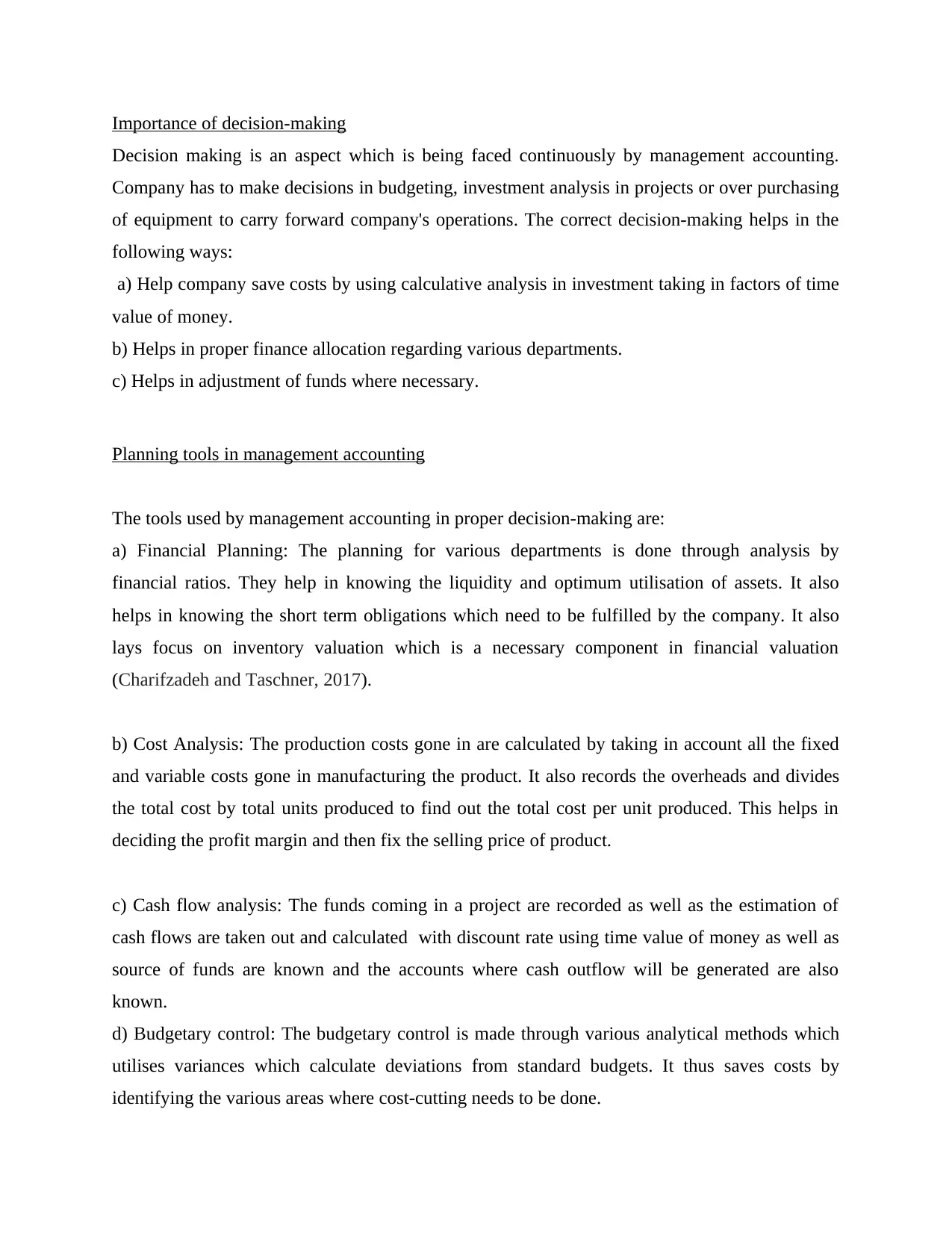
Importance of decision-making
Decision making is an aspect which is being faced continuously by management accounting.
Company has to make decisions in budgeting, investment analysis in projects or over purchasing
of equipment to carry forward company's operations. The correct decision-making helps in the
following ways:
a) Help company save costs by using calculative analysis in investment taking in factors of time
value of money.
b) Helps in proper finance allocation regarding various departments.
c) Helps in adjustment of funds where necessary.
Planning tools in management accounting
The tools used by management accounting in proper decision-making are:
a) Financial Planning: The planning for various departments is done through analysis by
financial ratios. They help in knowing the liquidity and optimum utilisation of assets. It also
helps in knowing the short term obligations which need to be fulfilled by the company. It also
lays focus on inventory valuation which is a necessary component in financial valuation
(Charifzadeh and Taschner, 2017).
b) Cost Analysis: The production costs gone in are calculated by taking in account all the fixed
and variable costs gone in manufacturing the product. It also records the overheads and divides
the total cost by total units produced to find out the total cost per unit produced. This helps in
deciding the profit margin and then fix the selling price of product.
c) Cash flow analysis: The funds coming in a project are recorded as well as the estimation of
cash flows are taken out and calculated with discount rate using time value of money as well as
source of funds are known and the accounts where cash outflow will be generated are also
known.
d) Budgetary control: The budgetary control is made through various analytical methods which
utilises variances which calculate deviations from standard budgets. It thus saves costs by
identifying the various areas where cost-cutting needs to be done.
Decision making is an aspect which is being faced continuously by management accounting.
Company has to make decisions in budgeting, investment analysis in projects or over purchasing
of equipment to carry forward company's operations. The correct decision-making helps in the
following ways:
a) Help company save costs by using calculative analysis in investment taking in factors of time
value of money.
b) Helps in proper finance allocation regarding various departments.
c) Helps in adjustment of funds where necessary.
Planning tools in management accounting
The tools used by management accounting in proper decision-making are:
a) Financial Planning: The planning for various departments is done through analysis by
financial ratios. They help in knowing the liquidity and optimum utilisation of assets. It also
helps in knowing the short term obligations which need to be fulfilled by the company. It also
lays focus on inventory valuation which is a necessary component in financial valuation
(Charifzadeh and Taschner, 2017).
b) Cost Analysis: The production costs gone in are calculated by taking in account all the fixed
and variable costs gone in manufacturing the product. It also records the overheads and divides
the total cost by total units produced to find out the total cost per unit produced. This helps in
deciding the profit margin and then fix the selling price of product.
c) Cash flow analysis: The funds coming in a project are recorded as well as the estimation of
cash flows are taken out and calculated with discount rate using time value of money as well as
source of funds are known and the accounts where cash outflow will be generated are also
known.
d) Budgetary control: The budgetary control is made through various analytical methods which
utilises variances which calculate deviations from standard budgets. It thus saves costs by
identifying the various areas where cost-cutting needs to be done.
Paraphrase This Document
Need a fresh take? Get an instant paraphrase of this document with our AI Paraphraser
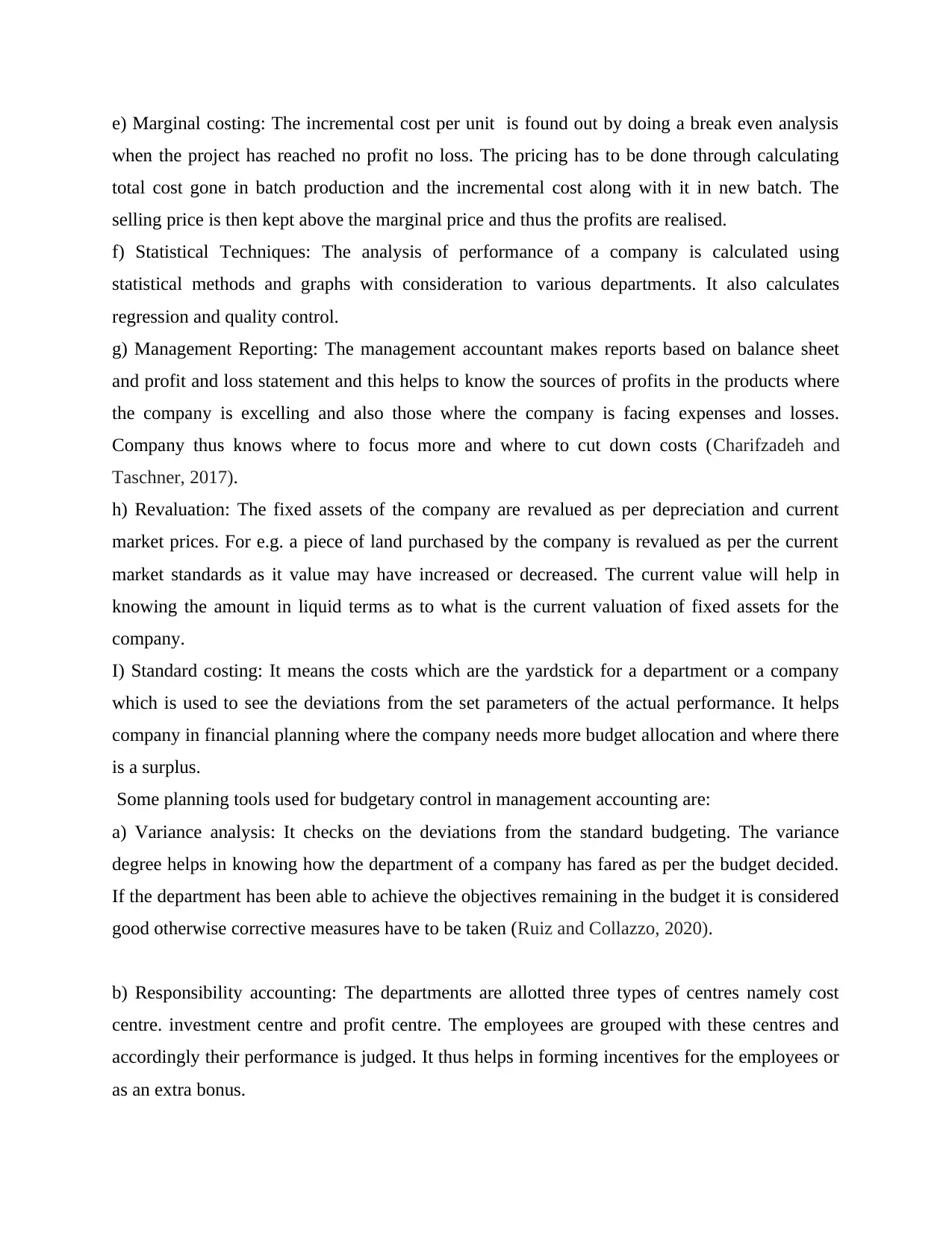
e) Marginal costing: The incremental cost per unit is found out by doing a break even analysis
when the project has reached no profit no loss. The pricing has to be done through calculating
total cost gone in batch production and the incremental cost along with it in new batch. The
selling price is then kept above the marginal price and thus the profits are realised.
f) Statistical Techniques: The analysis of performance of a company is calculated using
statistical methods and graphs with consideration to various departments. It also calculates
regression and quality control.
g) Management Reporting: The management accountant makes reports based on balance sheet
and profit and loss statement and this helps to know the sources of profits in the products where
the company is excelling and also those where the company is facing expenses and losses.
Company thus knows where to focus more and where to cut down costs (Charifzadeh and
Taschner, 2017).
h) Revaluation: The fixed assets of the company are revalued as per depreciation and current
market prices. For e.g. a piece of land purchased by the company is revalued as per the current
market standards as it value may have increased or decreased. The current value will help in
knowing the amount in liquid terms as to what is the current valuation of fixed assets for the
company.
I) Standard costing: It means the costs which are the yardstick for a department or a company
which is used to see the deviations from the set parameters of the actual performance. It helps
company in financial planning where the company needs more budget allocation and where there
is a surplus.
Some planning tools used for budgetary control in management accounting are:
a) Variance analysis: It checks on the deviations from the standard budgeting. The variance
degree helps in knowing how the department of a company has fared as per the budget decided.
If the department has been able to achieve the objectives remaining in the budget it is considered
good otherwise corrective measures have to be taken (Ruiz and Collazzo, 2020).
b) Responsibility accounting: The departments are allotted three types of centres namely cost
centre. investment centre and profit centre. The employees are grouped with these centres and
accordingly their performance is judged. It thus helps in forming incentives for the employees or
as an extra bonus.
when the project has reached no profit no loss. The pricing has to be done through calculating
total cost gone in batch production and the incremental cost along with it in new batch. The
selling price is then kept above the marginal price and thus the profits are realised.
f) Statistical Techniques: The analysis of performance of a company is calculated using
statistical methods and graphs with consideration to various departments. It also calculates
regression and quality control.
g) Management Reporting: The management accountant makes reports based on balance sheet
and profit and loss statement and this helps to know the sources of profits in the products where
the company is excelling and also those where the company is facing expenses and losses.
Company thus knows where to focus more and where to cut down costs (Charifzadeh and
Taschner, 2017).
h) Revaluation: The fixed assets of the company are revalued as per depreciation and current
market prices. For e.g. a piece of land purchased by the company is revalued as per the current
market standards as it value may have increased or decreased. The current value will help in
knowing the amount in liquid terms as to what is the current valuation of fixed assets for the
company.
I) Standard costing: It means the costs which are the yardstick for a department or a company
which is used to see the deviations from the set parameters of the actual performance. It helps
company in financial planning where the company needs more budget allocation and where there
is a surplus.
Some planning tools used for budgetary control in management accounting are:
a) Variance analysis: It checks on the deviations from the standard budgeting. The variance
degree helps in knowing how the department of a company has fared as per the budget decided.
If the department has been able to achieve the objectives remaining in the budget it is considered
good otherwise corrective measures have to be taken (Ruiz and Collazzo, 2020).
b) Responsibility accounting: The departments are allotted three types of centres namely cost
centre. investment centre and profit centre. The employees are grouped with these centres and
accordingly their performance is judged. It thus helps in forming incentives for the employees or
as an extra bonus.
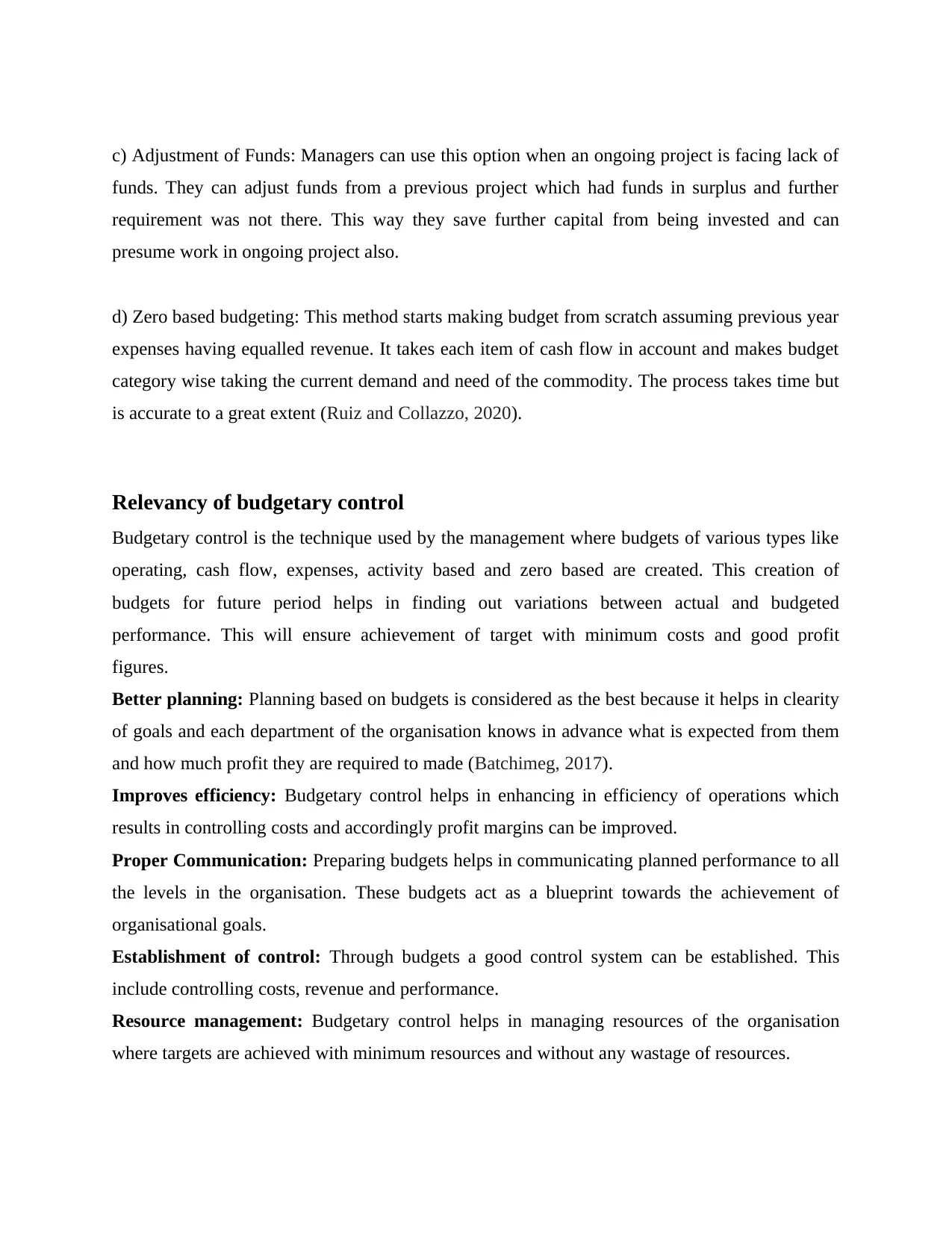
c) Adjustment of Funds: Managers can use this option when an ongoing project is facing lack of
funds. They can adjust funds from a previous project which had funds in surplus and further
requirement was not there. This way they save further capital from being invested and can
presume work in ongoing project also.
d) Zero based budgeting: This method starts making budget from scratch assuming previous year
expenses having equalled revenue. It takes each item of cash flow in account and makes budget
category wise taking the current demand and need of the commodity. The process takes time but
is accurate to a great extent (Ruiz and Collazzo, 2020).
Relevancy of budgetary control
Budgetary control is the technique used by the management where budgets of various types like
operating, cash flow, expenses, activity based and zero based are created. This creation of
budgets for future period helps in finding out variations between actual and budgeted
performance. This will ensure achievement of target with minimum costs and good profit
figures.
Better planning: Planning based on budgets is considered as the best because it helps in clearity
of goals and each department of the organisation knows in advance what is expected from them
and how much profit they are required to made (Batchimeg, 2017).
Improves efficiency: Budgetary control helps in enhancing in efficiency of operations which
results in controlling costs and accordingly profit margins can be improved.
Proper Communication: Preparing budgets helps in communicating planned performance to all
the levels in the organisation. These budgets act as a blueprint towards the achievement of
organisational goals.
Establishment of control: Through budgets a good control system can be established. This
include controlling costs, revenue and performance.
Resource management: Budgetary control helps in managing resources of the organisation
where targets are achieved with minimum resources and without any wastage of resources.
funds. They can adjust funds from a previous project which had funds in surplus and further
requirement was not there. This way they save further capital from being invested and can
presume work in ongoing project also.
d) Zero based budgeting: This method starts making budget from scratch assuming previous year
expenses having equalled revenue. It takes each item of cash flow in account and makes budget
category wise taking the current demand and need of the commodity. The process takes time but
is accurate to a great extent (Ruiz and Collazzo, 2020).
Relevancy of budgetary control
Budgetary control is the technique used by the management where budgets of various types like
operating, cash flow, expenses, activity based and zero based are created. This creation of
budgets for future period helps in finding out variations between actual and budgeted
performance. This will ensure achievement of target with minimum costs and good profit
figures.
Better planning: Planning based on budgets is considered as the best because it helps in clearity
of goals and each department of the organisation knows in advance what is expected from them
and how much profit they are required to made (Batchimeg, 2017).
Improves efficiency: Budgetary control helps in enhancing in efficiency of operations which
results in controlling costs and accordingly profit margins can be improved.
Proper Communication: Preparing budgets helps in communicating planned performance to all
the levels in the organisation. These budgets act as a blueprint towards the achievement of
organisational goals.
Establishment of control: Through budgets a good control system can be established. This
include controlling costs, revenue and performance.
Resource management: Budgetary control helps in managing resources of the organisation
where targets are achieved with minimum resources and without any wastage of resources.
⊘ This is a preview!⊘
Do you want full access?
Subscribe today to unlock all pages.

Trusted by 1+ million students worldwide
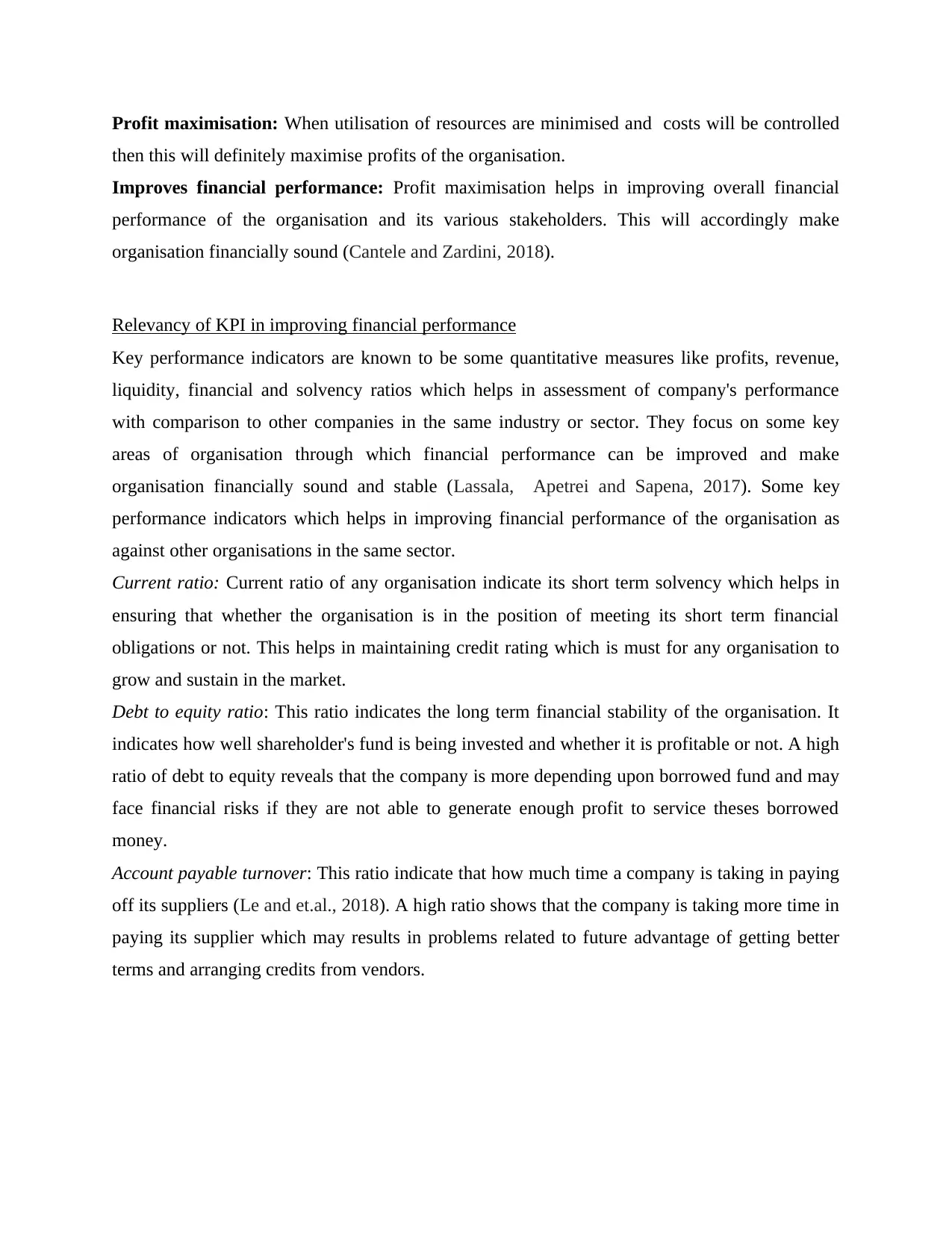
Profit maximisation: When utilisation of resources are minimised and costs will be controlled
then this will definitely maximise profits of the organisation.
Improves financial performance: Profit maximisation helps in improving overall financial
performance of the organisation and its various stakeholders. This will accordingly make
organisation financially sound (Cantele and Zardini, 2018).
Relevancy of KPI in improving financial performance
Key performance indicators are known to be some quantitative measures like profits, revenue,
liquidity, financial and solvency ratios which helps in assessment of company's performance
with comparison to other companies in the same industry or sector. They focus on some key
areas of organisation through which financial performance can be improved and make
organisation financially sound and stable (Lassala, Apetrei and Sapena, 2017). Some key
performance indicators which helps in improving financial performance of the organisation as
against other organisations in the same sector.
Current ratio: Current ratio of any organisation indicate its short term solvency which helps in
ensuring that whether the organisation is in the position of meeting its short term financial
obligations or not. This helps in maintaining credit rating which is must for any organisation to
grow and sustain in the market.
Debt to equity ratio: This ratio indicates the long term financial stability of the organisation. It
indicates how well shareholder's fund is being invested and whether it is profitable or not. A high
ratio of debt to equity reveals that the company is more depending upon borrowed fund and may
face financial risks if they are not able to generate enough profit to service theses borrowed
money.
Account payable turnover: This ratio indicate that how much time a company is taking in paying
off its suppliers (Le and et.al., 2018). A high ratio shows that the company is taking more time in
paying its supplier which may results in problems related to future advantage of getting better
terms and arranging credits from vendors.
then this will definitely maximise profits of the organisation.
Improves financial performance: Profit maximisation helps in improving overall financial
performance of the organisation and its various stakeholders. This will accordingly make
organisation financially sound (Cantele and Zardini, 2018).
Relevancy of KPI in improving financial performance
Key performance indicators are known to be some quantitative measures like profits, revenue,
liquidity, financial and solvency ratios which helps in assessment of company's performance
with comparison to other companies in the same industry or sector. They focus on some key
areas of organisation through which financial performance can be improved and make
organisation financially sound and stable (Lassala, Apetrei and Sapena, 2017). Some key
performance indicators which helps in improving financial performance of the organisation as
against other organisations in the same sector.
Current ratio: Current ratio of any organisation indicate its short term solvency which helps in
ensuring that whether the organisation is in the position of meeting its short term financial
obligations or not. This helps in maintaining credit rating which is must for any organisation to
grow and sustain in the market.
Debt to equity ratio: This ratio indicates the long term financial stability of the organisation. It
indicates how well shareholder's fund is being invested and whether it is profitable or not. A high
ratio of debt to equity reveals that the company is more depending upon borrowed fund and may
face financial risks if they are not able to generate enough profit to service theses borrowed
money.
Account payable turnover: This ratio indicate that how much time a company is taking in paying
off its suppliers (Le and et.al., 2018). A high ratio shows that the company is taking more time in
paying its supplier which may results in problems related to future advantage of getting better
terms and arranging credits from vendors.
Paraphrase This Document
Need a fresh take? Get an instant paraphrase of this document with our AI Paraphraser
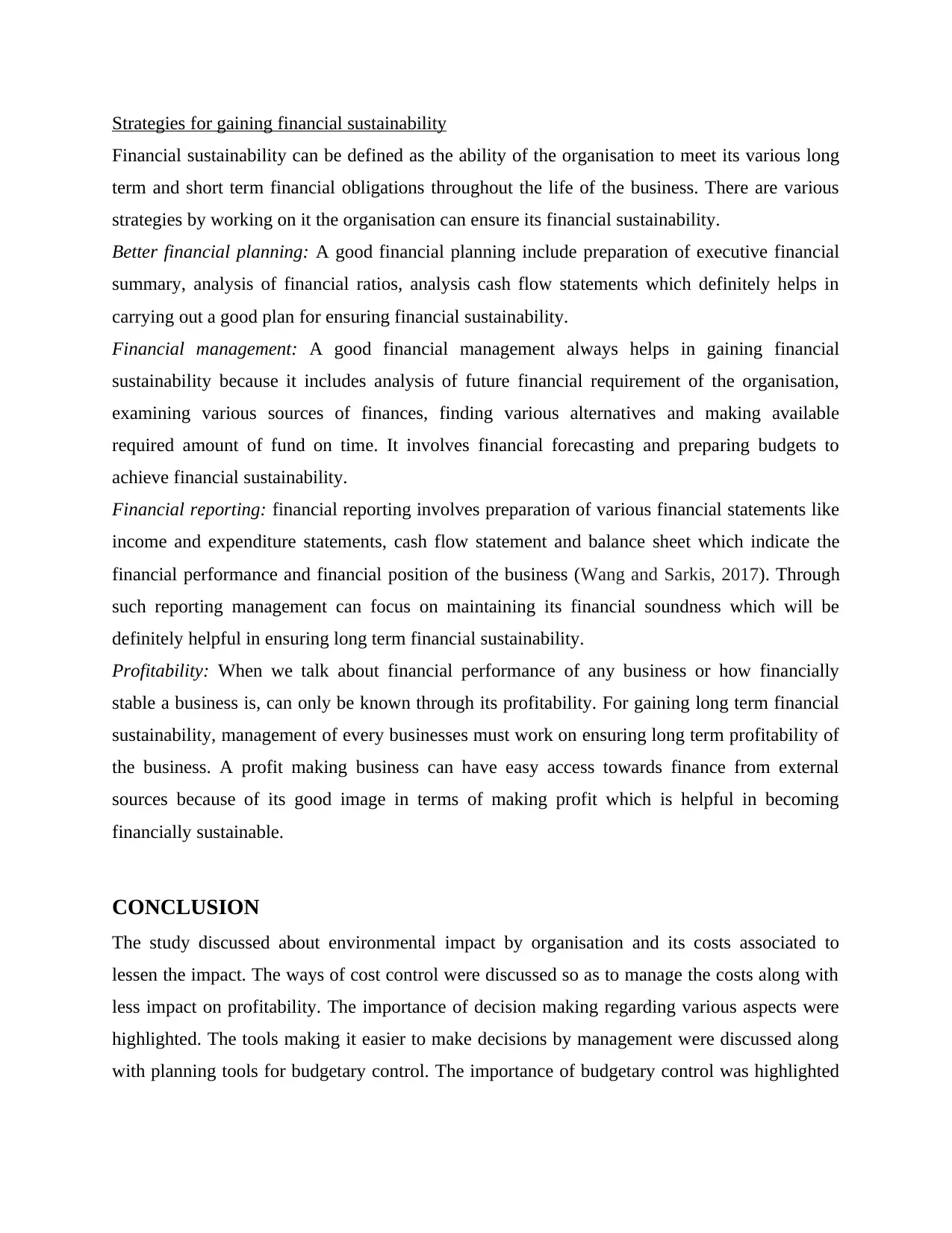
Strategies for gaining financial sustainability
Financial sustainability can be defined as the ability of the organisation to meet its various long
term and short term financial obligations throughout the life of the business. There are various
strategies by working on it the organisation can ensure its financial sustainability.
Better financial planning: A good financial planning include preparation of executive financial
summary, analysis of financial ratios, analysis cash flow statements which definitely helps in
carrying out a good plan for ensuring financial sustainability.
Financial management: A good financial management always helps in gaining financial
sustainability because it includes analysis of future financial requirement of the organisation,
examining various sources of finances, finding various alternatives and making available
required amount of fund on time. It involves financial forecasting and preparing budgets to
achieve financial sustainability.
Financial reporting: financial reporting involves preparation of various financial statements like
income and expenditure statements, cash flow statement and balance sheet which indicate the
financial performance and financial position of the business (Wang and Sarkis, 2017). Through
such reporting management can focus on maintaining its financial soundness which will be
definitely helpful in ensuring long term financial sustainability.
Profitability: When we talk about financial performance of any business or how financially
stable a business is, can only be known through its profitability. For gaining long term financial
sustainability, management of every businesses must work on ensuring long term profitability of
the business. A profit making business can have easy access towards finance from external
sources because of its good image in terms of making profit which is helpful in becoming
financially sustainable.
CONCLUSION
The study discussed about environmental impact by organisation and its costs associated to
lessen the impact. The ways of cost control were discussed so as to manage the costs along with
less impact on profitability. The importance of decision making regarding various aspects were
highlighted. The tools making it easier to make decisions by management were discussed along
with planning tools for budgetary control. The importance of budgetary control was highlighted
Financial sustainability can be defined as the ability of the organisation to meet its various long
term and short term financial obligations throughout the life of the business. There are various
strategies by working on it the organisation can ensure its financial sustainability.
Better financial planning: A good financial planning include preparation of executive financial
summary, analysis of financial ratios, analysis cash flow statements which definitely helps in
carrying out a good plan for ensuring financial sustainability.
Financial management: A good financial management always helps in gaining financial
sustainability because it includes analysis of future financial requirement of the organisation,
examining various sources of finances, finding various alternatives and making available
required amount of fund on time. It involves financial forecasting and preparing budgets to
achieve financial sustainability.
Financial reporting: financial reporting involves preparation of various financial statements like
income and expenditure statements, cash flow statement and balance sheet which indicate the
financial performance and financial position of the business (Wang and Sarkis, 2017). Through
such reporting management can focus on maintaining its financial soundness which will be
definitely helpful in ensuring long term financial sustainability.
Profitability: When we talk about financial performance of any business or how financially
stable a business is, can only be known through its profitability. For gaining long term financial
sustainability, management of every businesses must work on ensuring long term profitability of
the business. A profit making business can have easy access towards finance from external
sources because of its good image in terms of making profit which is helpful in becoming
financially sustainable.
CONCLUSION
The study discussed about environmental impact by organisation and its costs associated to
lessen the impact. The ways of cost control were discussed so as to manage the costs along with
less impact on profitability. The importance of decision making regarding various aspects were
highlighted. The tools making it easier to make decisions by management were discussed along
with planning tools for budgetary control. The importance of budgetary control was highlighted

for the organisation’s smooth functioning along with KPIs to indicate performance. Importance
of various financial ratios was depicted in context with organisation decision-making.
of various financial ratios was depicted in context with organisation decision-making.
⊘ This is a preview!⊘
Do you want full access?
Subscribe today to unlock all pages.

Trusted by 1+ million students worldwide
1 out of 14
Related Documents
Your All-in-One AI-Powered Toolkit for Academic Success.
+13062052269
info@desklib.com
Available 24*7 on WhatsApp / Email
![[object Object]](/_next/static/media/star-bottom.7253800d.svg)
Unlock your academic potential
Copyright © 2020–2025 A2Z Services. All Rights Reserved. Developed and managed by ZUCOL.





